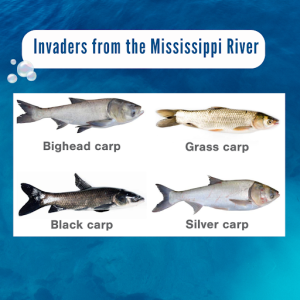Invaders from the Mississippi River: Illinois and Michigan Unite to Protect the Great Lakes
By Erin Scheg, C2ST Intern, Loyola University
The Great Lakes provide water for more than 40 million people, generate jobs for more than 1.5 million people, and are home to more than 3,500 plant and animal species. In early July 2024, the governors of Illinois and Michigan signed an agreement to cosponsor the Brandon Road Interbasin Project. This landmark project aims to protect the Great Lakes from invasive species, especially Asian carp. Invasive species are defined as non-native species to the ecosystem whose presence causes economic, environmental, or human health. Asian carp are native to Eastern Asia and were introduced to North America in the 1970s to assist with pest control in aquaculture facilities. Aquaculture facilities are aquatic farms where fish are grown and harvested for sale. These carp escaped into the wild from the aquatic farms on the Mississippi River and have been heading north, which poses a major threat to the native Great Lakes ecosystems.

“Asian carp” is a catch-all term for a group of related carp species that can grow to four feet long and weigh up to 100 pounds. The carp species identified in the Great Lakes are bighead carp, black carp, silver carp, and grass carp. Bighead carp and silver carp eat small plants and animals such as plankton and can eat up to 5-40% of their body weight in plankton each day. Grass carp feed on rooted plants and black carp feed on snails and mollusks. All of the Asian carp feed on organisms on the bottom level of the food chain, which could collapse the entire aquatic food chain. The invasive fish outcompete native primary consumers, such as calanoids and native water fleas, due to their size and aggressive behavior. Primary consumers are animals that eat plants. This reduces the native population resulting in a reduced population of secondary and tertiary consumers, such as walleye and lake whitefish. Secondary consumers are defined as animals that eat primary consumers and tertiary consumers are animals that eat secondary consumers. Additionally, since carp do not have predators in this food system, the population can continue to increase exponentially. The invasive species harm not only ecosystems but also commercial and recreational fishing industries. The commercial fishing industry in the Great Lakes is valued at over $7 billion, bringing in 50 million pounds of fish annually.
Invasive carp can migrate and spread farther into new territory through natural and human-caused methods. Carp can spread due to their ability to jump over barriers such as low dams, especially silver carp which can jump as high as ten feet. Furthermore, during high water conditions, the Mississippi River creates an open river for the fish to bypass barriers. Flooding also connects water bodies that are not normally connected which allows fish to enter new territory. In some cases, young carp are used as live bait which has led to spread in new water bodies. Additionally, barge and recreational watercraft passing through the Mississippi River may permit carp to pass through. Even a small population of carp in these ecosystems can cause catastrophic issues. An adult carp can quickly populate waters by laying hundreds of thousands of eggs at once. This fast reproduction rate expands the range and threat to ecosystems.
The main course of action to reduce these invasive species is preventing infiltration into the Great Lakes. The Brandon Road Interbasin Project involves installing multiple deterrents at Brandon Road Lock which is the key channel between the Mississippi River and the Great Lakes. These deterrents include structural components such as a flushing lock, electric barrier, and air bubble fences, along with non-structural measures like public education, pesticide use, monitoring, and manual removal of non-native species. This project, which will span multiple years, will be funded with $114 million from Illinois and Michigan and $247 million from the federal government. The goal is to start the project as soon as possible. This agreement protects the Great Lake aquatic ecosystem, local communities, and fishing/boating industries. The Brandon Road Interbasin Project is an example of how policies can benefit the environment.
References
- www.courthousenews.com/illinois-michigan-reach-deal-on-1-15-billion-project-to-protect-great-lakes-from-invasive-species/
- www.glc.org/lakes/#:~:text=The%20system%20is%20invaluable%20as
- www.glfc.org/asian-carp.php
- tnwf.org/asian-carp-a-call-to-action/
- www.nps.gov/miss/learn/nature/ascarpover.htm
- news.umich.edu/asian-carp-capable-of-surviving-in-much-larger-areas-of-lake-michigan-than-previously-thought/
- www.invasivespeciesinfo.gov/what-are-invasive-species